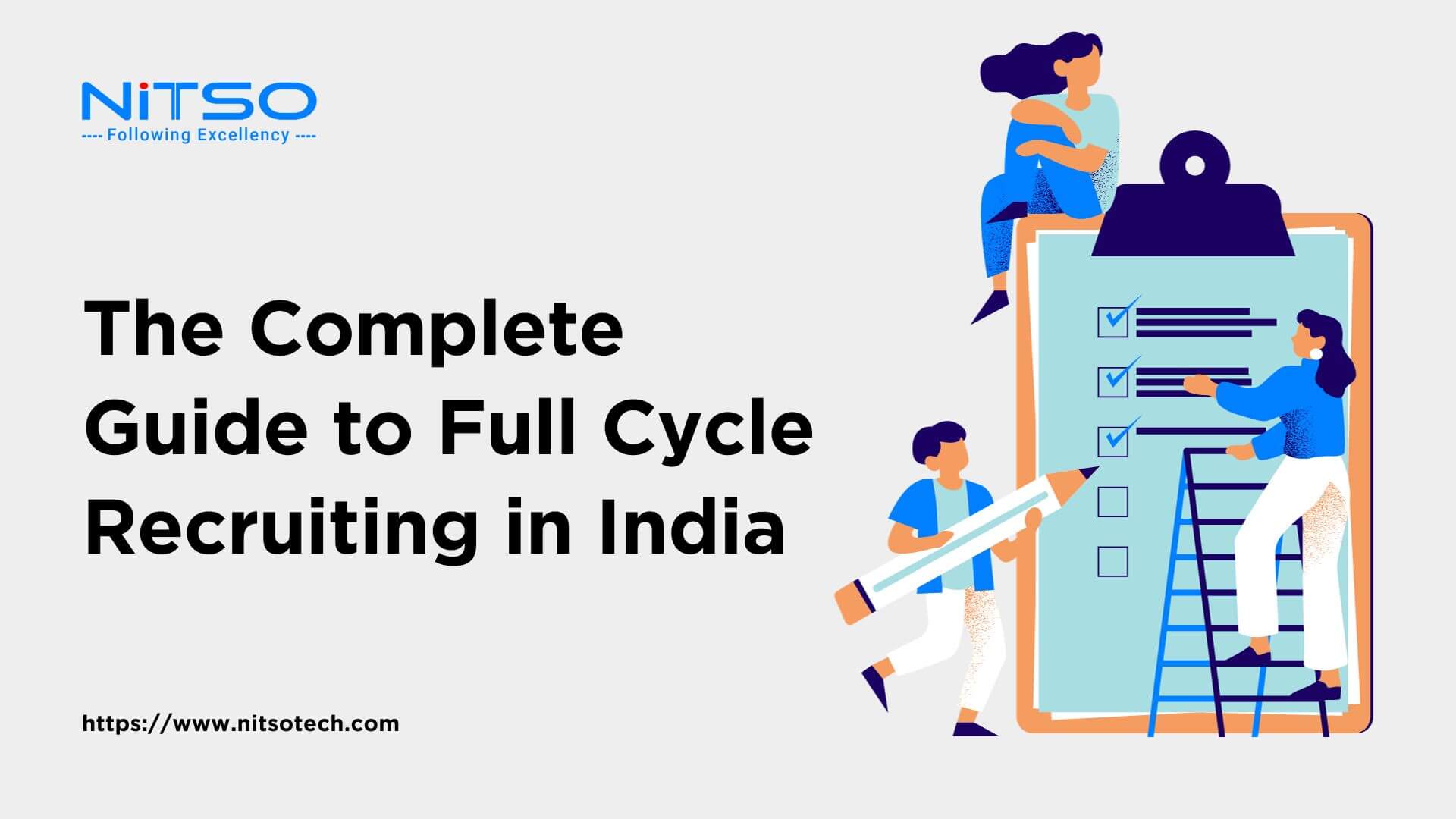Finding and hiring top talent is more challenging than ever in India’s competitive job market. To meet this challenge, more organizations are adopting full cycle recruiting – an end-to-end process where a single recruiter shepherds candidates through the entire hiring journey.
Full cycle recruiting aims to provide a seamless experience for candidates while giving recruiters more ownership and visibility into hiring outcomes. This approach brings many benefits including improved efficiency, better quality hires, and stronger recruiter capabilities. However, it also comes with challenges around skill requirements and workload management for recruiters.
As talent acquisition stakes intensify, Indian companies are realizing the advantages of full cycle recruiting for competing for today’s top talent. This article will provide a comprehensive overview of full cycle recruiting including its meaning, key steps, required skills, and best practices for implementation. Understanding this methodology can help organizations enhance their recruiting success in India’s dynamic job market.
Table of Contents
What is Full Cycle Recruiting?
Full cycle recruiting refers to a comprehensive process where a single recruiter is accountable for the entire candidate journey from start to finish. The recruiter handles all aspects including:
- Identifying hiring needs and job requirements
- Sourcing and attracting qualified candidates
- Screening resumes and profiles
- Scheduling and conducting interviews
- Managing assessments and selection processes
- Extending job offers and negotiating terms
- Preparing for and handling onboarding
The recruiter also provides ongoing support and follows up after hiring. Rather than handing off candidates between specialized roles, full cycle recruiting empowers a single recruiter to take complete ownership.
This methodology differs from traditional recruiting where different people handle individual stages like sourcing, screening, interviewing, assessments, and onboarding. Full cycle recruiting consolidates these responsibilities with one dedicated recruiter per hire.
This end-to-end approach provides visibility into the bigger picture that is lost with fragmented recruiting. It enables the recruiter to better understand needs, ensure a smooth experience, and take direct accountability for outcomes. As talent competition grows in India, full cycle recruiting is becoming a crucial component of recruitment success.
The Key Benefits of Full Cycle Recruiting
Implementing full cycle recruiting offers a multitude of benefits that make the effort worthwhile. From improved efficiencies to better hiring outcomes, let’s explore the most important benefits:
- Improved candidate experience – With a single point of contact, candidates have a smoother journey rather than being handed between recruiters.
- Increased efficiency – Consolidating stages under one recruiter eliminates handoffs and bottlenecks. This speeds up hiring.
- Enhanced hiring manager satisfaction – Hiring managers have a dedicated recruiter overseeing the whole process and priorities.
- Better quality hires – The recruiter gains better insights into both the role and candidates along the entire journey. This enables more informed selection.
- Stronger recruiter capabilities – Full cycle recruiters build well-rounded skills in sourcing, assessing, interviewing, hiring, negotiating and onboarding.
- Direct accountability – When the same recruiter handles everything, they take greater ownership over outcomes. This drives continuous improvement.
- Talent pipeline development – Ongoing engagement between recruiters and candidates enables stronger relationship building.
As competition for top talent escalates in India, the advantages of full cycle recruiting make it an important recruitment strategy for ambitious employers.
Challenges of Full Cycle Recruiting
While the benefits are substantial, full cycle recruiting also comes with some notable challenges. Implementing a full cycle recruiting model requires overcoming some common obstacles:
- The broader skillset required – Full cycle recruiters need expertise across more stages compared to specialized recruiters focused on just sourcing or screening.
- Steeper learning curve – Developing end-to-end capabilities can have a more intense ramp-up for recruiters accustomed to narrower responsibilities.
- More workload – Managing the entire hiring process can represent a heavier workload than recruiters are used to handling. Strong organization and time management become crucial.
- Complex coordination – Juggling multiple open roles at once and coordinating all the moving pieces can be complicated to orchestrate smoothly.
- New mindset required – Taking direct ownership over outcomes requires a shift in mindset for recruiters used to passing candidates between siloed roles.
With careful preparation and training, organizations can equip recruiters to take on the challenges of full cycle recruiting and reap the substantial rewards it offers.
Steps in the Full Cycle Recruiting Process
Once you commit to full cycle recruiting, what are the nuts and bolts of the end-to-end process? Here we’ll break down the key stages involved.
- Identifying Hiring Needs – The recruiter partners with hiring managers to understand open roles and requirements. This shapes the rest of the process.
- Sourcing Candidates – The recruiter utilizes various channels to attract and engage qualified, interested candidates.
- Screening and Selecting – Resumes and profiles are screened for best fits. The recruiter identifies top candidates to advance.
- Interviewing – The recruiter coordinates and conducts initial interviews and any additional rounds.
- Assessments – The recruiter determines and handles any assessments needed.
- Evaluating and Recommending – Based on interviews and assessments, the recruiter evaluates fit and provides input to the hiring manager.
- Offer Process – The recruiter extends job offers, negotiates terms, and secures accepted offers.
- Onboarding – The recruiter spearheads onboarding activities and follows up in the initial weeks on the job.
With its expansive scope, full cycle recruiting requires extensive coordination and focus. But the payoff can be game-changing talent acquisition success.
Key Skills and Qualities of a Successful Full Cycle Recruiter
To excel as a full cycle recruiter requires building a diverse and specialized skillset across multiple functions:
- Sourcing expertise – Mastering various sourcing strategies and channels to surface qualified, interested candidates at scale.
- Interviewing skills – Conducting insightful interviews that assess candidates’ skills, fit and potential.
- Critical thinking – Evaluating candidates based on multiple sources of data to make sound recommendations.
- Project management – Coordinating and tracking many moving pieces simultaneously to keep the process on track.
- Relationship building – Forging trusted partnerships with hiring managers, candidates and stakeholders.
- Communication skills – Keeping all parties updated in real-time through effective communication.
- Coaching skills – Guiding managers and candidates through assessments, interviews, offers and onboarding.
- Negotiation skills – Navigating job offers and terms to secure win-win outcomes.
- Organizational skills – Juggling multiple open roles efficiently through sharp prioritization and workflow management.
With this expansive skillset, full cycle recruiters can truly master end-to-end hiring and provide immense value.
Best Practices for Implementing Full Cycle Recruiting
When making the transition to full cycle recruiting, following certain best practices can ensure a smoother rollout and faster results:
- Phase it in gradually – Changing all at once is high risk. Phase in by role, team or location.
- Train extensively – Invest in expanding recruiters’ skills across the entire process through training and job shadowing.
- Set clear expectations – Communicate performance standards and metrics around full cycle ownership.
- Get leadership buy-in – Ensure executives and hiring managers understand and support the transition.
- Develop process guides – Create cheat sheets and checklists to assist recruiters in managing the end-to-end process.
- Encourage collaboration – Have recruiters share expertise and problem-solve hiring challenges together.
- Automate where possible – Automating administrative tasks helps recruiters focus on higher-value work.
- Measure and iterate – Continuously gather data, feedback and insights to refine the approach over time.
- Reward success – Praise and incentivize recruiters to achieve full cycle recruiting wins.
With sufficient planning and support, the switch to full cycle recruiting can transform talent acquisition performance.
Article you might be interested in: 7 Key Talent Acquisition Strategies for Better Hiring
Conclusion
As competition for top talent accelerates, full cycle recruiting is becoming a must-have capability for leading companies in India. While the transition doesn’t happen overnight, the benefits make it a worthwhile investment.
With a single recruiter owning the entire journey, candidates enjoy a streamlined experience. Meanwhile, recruiters build more expansive capabilities and get the satisfaction of shepherding hires from start to finish.
However, organizations must arm recruiters with the diverse skills needed and address the workload challenges that can arise. With adequate training and support, recruiters can thrive in the full cycle model.
When done right, full cycle recruiting enhances efficiency, accountability, hiring quality, and recruiter development. In today’s war for talent, companies will increasingly rely on full cycle recruiters to source, hire and onboard A-player talent faster and more effectively than the competition.
Frequently Asked Questions (FAQs)
What is full cycle recruiting?
Full cycle recruiting is an end-to-end talent acquisition process where one recruiter oversees the entire candidate journey from identifying hiring needs to onboarding new hires.
What are the main benefits of full cycle recruiting?
Benefits include improved candidate experience, hiring manager satisfaction, hiring speed/efficiency, recruiter capabilities, accountability, and quality of hires.
What additional skills are required for full cycle recruiting?
Full cycle recruiters need excellent communication, project management, decision-making, interviewing, assessment, negotiation, and onboarding skills.
What are some challenges of implementing full cycle recruiting?
Challenges include increased workload, steeper learning curves, the need for broader skills, and managing higher complexity with coordinating.
How should companies transition to a full cycle recruiting model?
Best practices are to phase it in gradually, train recruiters extensively, set clear expectations, get leadership buy-in, develop process guides and resources, encourage collaboration, automate where possible, and continuously gather feedback.
How does full cycle recruiting impact the candidate experience?
Candidates have an improved, smoother experience with a single recruiter guiding them through the entire process instead of being passed between recruiters.
How can full cycle recruiting improve hiring outcomes?
Full lifecycle visibility and accountability enable recruiters to make more informed hiring decisions and continuously refine the process.








0 Comments